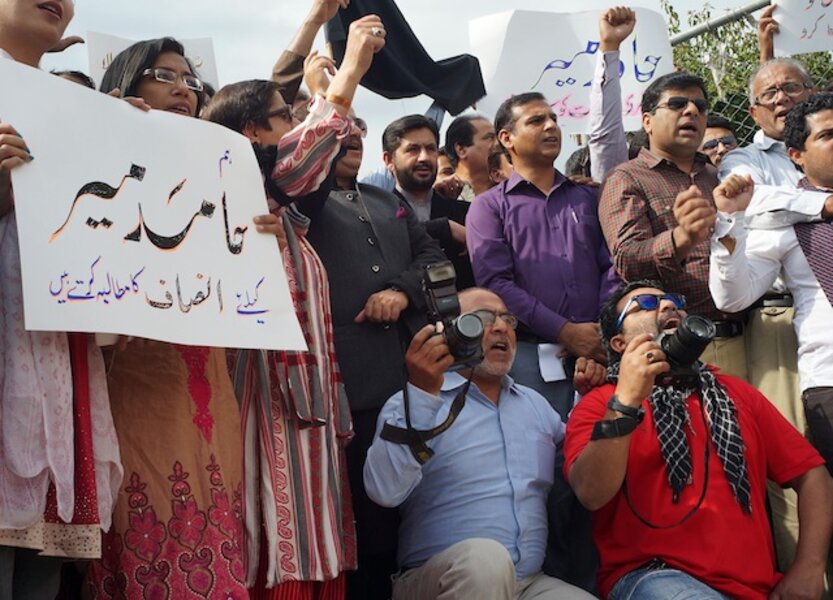Why Pakistan's largest private broadcaster may soon go dark
Loading...
| Islamabad, Pakistan
The attempted assassination of a leading TV anchor in Karachi has triggered a rift within the Pakistan media and an unprecedented move to revoke the broadcaster's license.
The Ministry of Defense filed a request today to shut down Geo TV, the country’s largest media organization, on charges of maligning the military’s powerful Inter-Services Intelligence directorate, the ISI.
The issue is not solely a matter of the military vs. Geo. Far from defending Geo and the broader cause of media freedom, rival media groups are blaming Geo for irresponsible journalism after it suggested the ISI was behind Saturday's attack on its anchor Hamid Mir.
“Hamid Mir’s attack has become a cause for media division. Other news channels are now settling their own scores by maligning Geo TV,” says Adnan Rehmat, director of media development at Civic Action Resources, an independent media monitoring group.
Mr. Mir, who is undergoing treatment at a Karachi hospital, was shot at least six times on Saturday by unknown gunmen while traveling from Karachi airport to his office.
What separates Mr. Mir’s attack from others on Pakistani journalists – at least five journalists and three media assistants have been killed in the past twelve months – is Geo's robust response. After the attack it carried on-air accusations that Mr. Mir felt threatened by the ISI. The station also broadcast pictures of ISI chief Lt. Gen Zahir ul-Islam while talking about the incident, and one anchor called for Mr. Islam’s resignation, a highly unusual and blunt remark in Pakistan.
Mr. Mir’s younger brother, who is also a journalist, said on air that before the attack his brother had told him and his editors at Geo that he was being threatened by the ISI. The apparent reason was Mr. Mir's coverage of missing persons in the province of Balochistan and of the trial of former President and Army chief Gen. (ret.) Pervez Musharraf.
The military has not been the only one to criticize Geo’s coverage of the attack. News groups like ARY and Express Media have called Geo's coverage "poisonous" and charged that it has a "foreign agenda." A social media campaign with the slogans #ShutUpGeo and #BanGeo has been running on Twitter and Facebook.
Mr. Rehmat believes that Geo put the accusations against the ISI on air in haste, and as a result, failed to keep the focus on the assassination attempt and the dangers of reporting in Pakistan.
“The assassination attempt has become irrelevant and now power players are pitted against each other. And the military has forced news channels to take a position, i.e. either you are with them or against them,” he says.
Safety threats and a young journalism industry
The Pakistani media industry, especially private broadcasters, has flourished in the past decade since then President Musharraf allowed private news channels. There are more than 40 news channels and the media is often praised for putting pressure on politicians. But the media also has a reputation for being young and unruly, and some observers say that the business interests of media owners outweigh their commitment to the public interest.
“Pakistani media owners mostly toe the line of the military to protect their business concerns, since they know military is the most important political stakeholder in the country,” says Rehmat.
There is also the issue of self-censorship due to repeated attacks against Pakistan journalists.
According to Pakistan Press Foundation at least 48 journalists have been killed in Pakistan since 2002. The Committee to Protect Journalists ranks Pakistan as one of the five most dangerous places to be a journalist.
The insurgency in Pakistan led by the Pakistan Taliban (TTP), based in the tribal belt next to Afghanistan, has also contributed to an environment of fear about reporting independently. The Taliban has claimed four attacks against Pakistani journalists over the past year, including an attack in January on an Express News van in Karachi that killed three people.
The media are caught between the interests of the Pakistan Taliban and the state security agencies, says Pervez Hoodbhoy, a professor at Forman Christian College in Lahore, who studies civil, military and militancy issues.
“It is unclear who is behind the attack on Mir. While it could be the ISI or some other intelligence agency, it could equally well be an Islamic militant group. It is significant to note that the TTP has taken responsibility for attacks on media in recent past,” he says.
Partly as a result of self-censorship due to security concerns, Mr. Hoodbhoy feels Pakistan's media rarely informs and frequently misleads. “It is torn between two powerful forces - the military establishment and the Islamic jihadists. Expectedly, there is confusion on who tried to kill Mir, and the truth has become the casualty,” he says.






